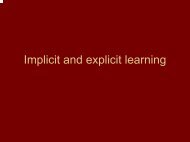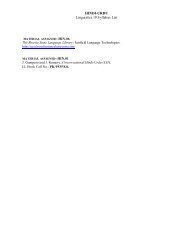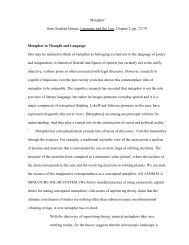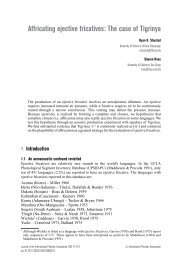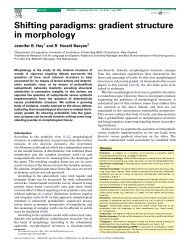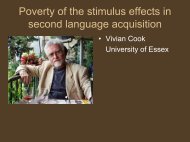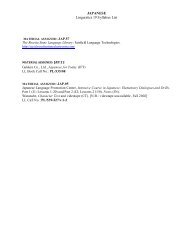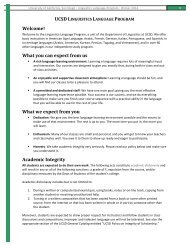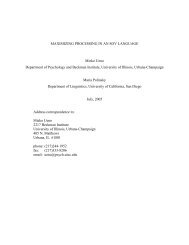Paradigms and Periphrastic Expression - Linguistics - UC San Diego
Paradigms and Periphrastic Expression - Linguistics - UC San Diego
Paradigms and Periphrastic Expression - Linguistics - UC San Diego
Create successful ePaper yourself
Turn your PDF publications into a flip-book with our unique Google optimized e-Paper software.
24. 2 nd past tense ( = perfect): perfect participle optionally inflected for person/number with<br />
markers from possessive paradigm <strong>and</strong> both affirmative <strong>and</strong> negative expressed synthetically.<br />
13<br />
H. [POL:aff], [TNS: 2 nd past], [MOOD:narrative]: [POL:neg], [TNS: 2 nd past], [MOOD:narrative]<br />
SG.1. mVni» j kem SG.1. mVni» j kVmte(je)<br />
2. mVnem(ed) 2. mVnVmtejed<br />
3. mVnem(ez) ‘s/he went (they say)’ 3. mVnVmte(jez) ‘s/he didn’t go (they say)’<br />
PL.1 mVni» j kemmV PL.1. mVni¹ j kVmtemV<br />
2. mVnil j l j am(dV) 14 2. mVnil’l’amte(dV)<br />
3. minil j l j am(zV) 3. mVnil j l j amte(zV)<br />
25. Paradigm effects:<br />
• 1 st person stem in both affirmative <strong>and</strong> negative is mVni» j k-, similar to present tense stem.<br />
• Since the perfect participle is interpreted as a finite predicate, it participates in a<br />
SUBJ/PREDICATE agreement paradigm, as do all predicates. 15<br />
À A verbal lexeme L with feature values [POL:aff], [TNS: 2 nd past], [MOOD:narrative], [PERS:<br />
], [NUM: ] has synthetic exponence.<br />
À A verbal lexeme L with feature values [POL:neg], [TNS: 2 nd past], [MOOD:narrative], [PERS:<br />
], [NUM: ] has synthetic exponence.<br />
IV. Conclusions<br />
• Formal exponence, ie., spell-outs, whether synthetic or periphrastic, appear to be keyed to<br />
morphosyntactic feature sets defining particular paradigms.<br />
13 There is an alternative periphrastic expression of this past <strong>and</strong> polarity combination which will be<br />
ignored here. Synthetic expression is claimed to occur in the literary language <strong>and</strong> to derive from southern<br />
dialects, while periphrastic expression is associated with northern dialects. (see Teplja»ina & Lytkin<br />
1976:180.)<br />
14 According to Serebrennikov 1963:264, the stem forms in the 2 nd <strong>and</strong> 3 rd plural represent innovations<br />
containing a presumptive distributive aspect marker -il j l j a suffixed to the root mVn-: the 2 nd <strong>and</strong> 3 rd original<br />
plural forms resembled the 2 nd <strong>and</strong> 3 rd singulars <strong>and</strong> were mVnem(ed) <strong>and</strong> mVnem(zV), respectively. The<br />
original pattern of verbal root + perfect marker + possessive marker exists for all person/number<br />
combinations in the language most closely related to Votyak, namely, Komi (see RJdei 1978:81). In<br />
western Uralic the perfect is generally realized analytically by means of a past participle <strong>and</strong> present tense<br />
form of the copula inflected for person/number, while in eastern Uralic (as above) there is synthetic<br />
realization using a perfect participle inflected for person/number.<br />
15 The fact that markers from the possessive paradigm are used for subject/predicate agreement, in this<br />
tense presumably reflects the status of the perfective forms as adjectives <strong>and</strong> nominals: this categorial status<br />
also explains why it is possible to have synthetic negative variants with the suffix -mte which otherwise<br />
combine with both infinitives <strong>and</strong> perfect participles functioning as adjectives.<br />
10



